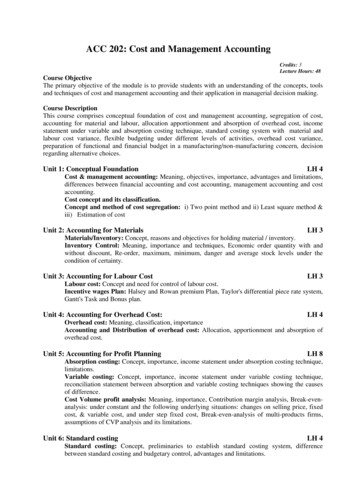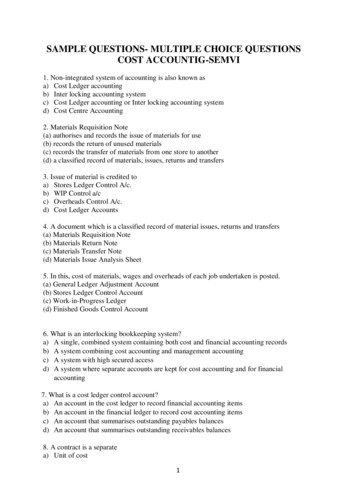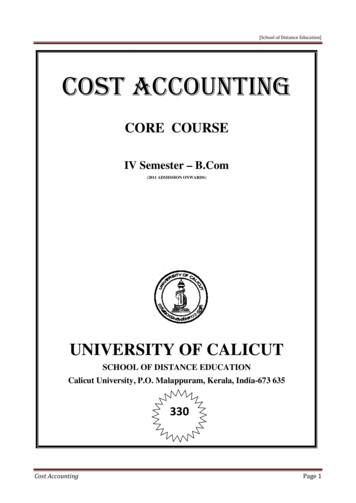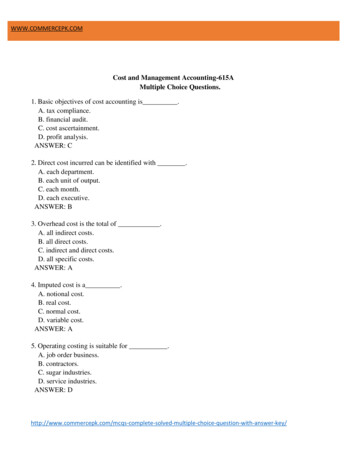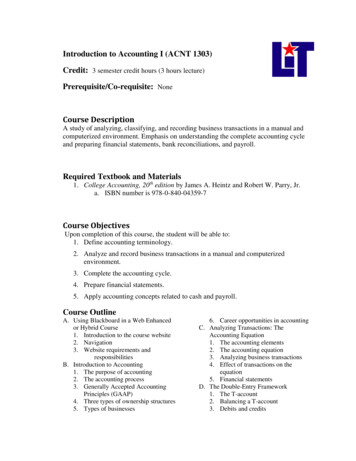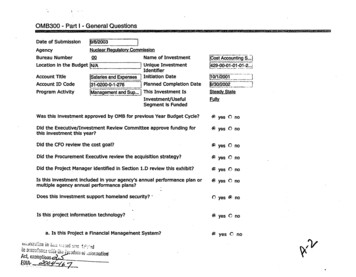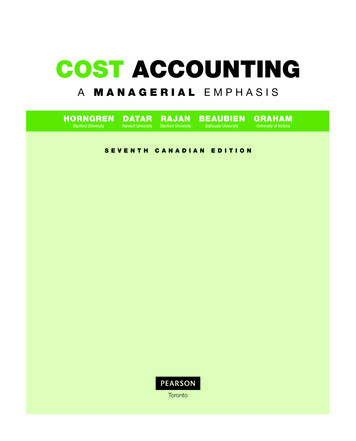
Transcription
COST ACCOUNTINGA MANAGERIAL EMPHASISHORNGRENDATARRAJANBEAUBIENGRAHAMStanford UniversityHarvard UniversityStanford UniversityDalhousie UniversityUniversity of VictoriaS EVE N THC A N A D I A NE D I TI ONTorontoA01 HORN8443 07 SE FM.indd i9/18/14 1:46 PM
Vice-President, Cross Media & Publishing Services: Gary BennettManaging Editor, Business Publishing: Claudine O’DonnellAcquisition Editor: Megan FarrellMarketing Manager: Claire VarleyDevelopment Team Lead: Suzanne SchaanDevelopmental Editor: Suzanne Simpson MillarProgram Manager: Patricia CiardulloProject Manager: Sarah GallagherProduction Editor: Vastavikta Sharma, Cenveo Publisher ServicesCopy Editor: Laurel SparrowProofreader: Marg BuktaFull Service Vendor: Cenveo Publisher ServicesPermissions Project Manager: Joanne TangPhoto Researcher: AptaraPermissions Researcher: AptaraArt Director: Zena DenchikCover Designer: Anthony LeungInterior Designer: Anthony LeungCover Image: Don Wilkie/Getty ImagesCredits and acknowledgments for the material borrowed from other sources and reproduced, with permission, in this textbookappear on the appropriate page within the text.Original edition published by Pearson Education, Inc., Upper Saddle River, New Jersey, USA. Copyright 2001 PearsonEducation, Inc. This edition is authorized for sale only in Canada.If you purchased this book outside the United States or Canada, you should be aware that it has been imported without theapproval of the publisher or the author.Copyright 2015, 2013, 2009, 2005 Pearson Canada Inc. All rights reserved. Manufactured in the United States of America.This publication is protected by copyright and permission should be obtained from the publisher prior to any prohibitedreproduction, storage in a retrieval system, or transmission in any form or by any means, electronic, mechanical, photocopying,recording, or likewise. To obtain permission(s) to use material from this work, please submit a written request to Pearson CanadaInc., Permissions Department, 26 Prince Andrew Place, Don Mills, Ontario, M3C 2T8, or fax your request to 416-447-3126, orsubmit a request to Permissions Requests at www.pearsoncanada.ca.10 9 8 7 6 5 4 3 2 1 [WC]Library and Archives Canada Cataloguing in PublicationHorngren, Charles T., 1926-, authorCost accounting : a managerial emphasis / Charles T. Horngren,Srikant M. Datar, Madhav V. Rajan, Louis Beaubien, Chris Graham.—7th Canadian edition.Includes index.Revision of: Cost accounting : a managerial emphasis / Charles—Don Mills,Ont. : Pearson Canada, 2012.ISBN 978-0-13-313844-3 (pbk.)T. Horngren . [et al.].—6th Canadian ed.1. Cost accounting—Textbooks. I. Title.HF5686.C8H59 2015658.15’11C2014-904869-6ISBN 978-0-13-313844-3A01 HORN8443 07 SE FM.indd ii9/18/14 7:22 PM
To Our FamiliesThe Horngren Family (CH)Swati, Radhika, Gayatri, Sidharth (SD)Gayathri, Sanjana, Anupama (MVR)This effort is dedicated to Ian, Megan, Evan, Lucy, Alec and Molly(and Charlie, too).-Louis BeaubienTo Professor Howard Teal (a previous Canadian author of Horngrenet al.) who, along with Professor Rick Robertson, first got me excited aboutaccounting. And to my wife Joan and daughter Adrienne, who put up with/supported me during my “creative” process!-Chris GrahamiiiA01 HORN8443 07 SE FM.indd iii9/18/14 1:46 PM
A01 HORN8443 07 SE FM.indd iv9/18/14 1:46 PM
Brief ContentsPreface xivPart One Cost Accounting Fundamentals 11 The Accountant’s Vital Role in Decision Making 12 An Introduction to Cost Terms and Purposes 243 Cost–Volume–Profit Analysis 574 Job Costing 975 Activity-Based Costing and Management 134Available online on MyAccountingLab: End-of-Part Case - Part 1: Katherine’s Truffle Kreations—TheEarly YearsPart Two Tools For Planning And Control 1726 Master Budget and Responsibility Accounting 1727 Flexible Budgets, Variances, and Management Control: I 2268 Flexible Budgets, Variances, and Management Control: II 2759 Income Effects of Denominator Level on Inventory Valuation 318Available online on MyAccountingLab: End-of-Part Case - Part 2: Katherine’s Chocolate Kreations—TheSecond StorePart Three Cost Information For Decisions 35910 Analysis of Cost Behaviour 35911 Decision Making and Relevant Information 40912 Pricing Decisions: Profitability and Cost Management 45313 Strategy, the Balanced Scorecard, and Profitability Analysis 489Available online on MyAccountingLab: End-of-Part Case - Part 3: Katherine’s Chocolate Kompany GoesPublicPart Four Cost Allocation And Revenues 52514 Period Cost Application 52515 Cost Allocation: Joint Products and Byproducts 56116 Revenue and Customer Profitability Analysis 59617 Process Costing 63918 Spoilage, Rework, and Scrap 681Available online on MyAccountingLab: End-of-Part Case - Part 4: Non-Manufacturing Costs (and Benefits)Part Five Control and Budgeting Strategies 71219 Inventory Cost Management Strategies 71220 Capital Budgeting: Methods of Investment Analysis 75221 Transfer Pricing and Multinational Management Control Systems 79422 Multinational Performance Measurement and Compensation 827Available online on MyAccountingLab: End-of-Part Case - Part 5: Consolidating Manufacturing; End-ofPart Case - Part 6: Winnipeg Beckons; End-of-Part Case: Batteries for Everyone: Assessing PerformanceAppendix A Notes on Compound Interest and Interest Tables 871Glossary 877Name Index 892Subject Index 896A01 HORN8443 07 SE FM.indd vv9/18/14 7:39 PM
VI CONTENTSTable of ContentsPreface xivPart One Cost AccountingFundamentals 11 The Accountant’s Vital Role in DecisionMaking 1iTunes Variable Pricing: Downloads Are Down, but ProfitsAre UpAccounting Systems: Financial and ManagementAccounting 2Strategic Decisions and Management Accounting 3Value-Chain And Supply-Chain Analysis and KeySuccess Factors 4Value-Chain Analysis 4Supply-Chain Analysis 5Key Success Factors (KSF) 5Concepts in Action: Management AccountingBeyond the NumbersDecision Making, Planning, and Control: The Five-StepDecision-Making Process 7Key Management Accounting Guidelines andOrganization Structure 9Cost–Benefit Approach 9Behavourial and Technical Considerations 9Different Costs for Different Purposes 10Corporate Structure and Governance: Accountability,Ethics, and Social Responsibility 10Corporate Governance 11Professional Ethics 12Institutional Support 12Corporate Social Responsibility (CSR) 13Sustainability Accounting 14Alternative Reporting 15Pulling It All Together—Problem for Self-Study 16 SummaryPoints 17 Terms to Learn 17 Assignment Material 18 ShortAnswer Questions 18 Exercises 18 Problems 20 CollaborativeLearning Case 232 An Introduction to Cost Terms andPurposes 24High Fixed Costs Bankrupt Twinkie MakerCosts and Cost Terminology 25Commonly Used Classifications of ManufacturingCosts 25Direct Costs and Indirect Costs 26Factors Affecting Direct/Indirect Cost Classifications 27Prime Costs and Conversion Costs 27Cost-Behaviour Patterns: Variable Costs and FixedCosts 28viA01 HORN8443 07 SE FM.indd viVariable Costs 28Fixed Costs 28Cost Drivers 30Concepts in Action: How AutoShare ReducesBusiness Transportation CostsTotal Costs and Unit Costs 31Unit Costs 31Cost of Goods Sold and the Statement ofComprehensive Income 32Inventory Valuation and the Statement of FinancialPosition 34Types of Inventory 35Inventoriable Costs 35Period Costs 35Illustrating the Flow of Inventoriable Costs: AManufacturing-Sector Example 36Inventoriable Costs and Period Costs for aMerchandising Company 38Measuring and Classifying Costs Requires Judgment 38Measuring Labour Costs 38Decision Framework and Flexibility of CostingMethods 40Concepts in Action: Don’t Overcharge the GovernmentPulling It All Together—Problem for Self-Study 42 SummaryPoints 43 Terms to Learn 44 Assignment Material 44 ShortAnswer Questions 44 Exercises 45 Problems 50 CollaborativeLearning Cases 553 Cost–Volume–Profit Analysis 57How “The Biggest Rock Show Ever” Turned a Big ProfitEssentials of CVP Analysis 58CVP Analysis: An Example 58Expressing CVP Relationships 60Contribution Margin Percentage: Breakeven Point inRevenue 63Using CVP to Calculate a Target Operating Income 63Contribution Margin, Gross Margin, Operating Margin,and Net Income Margin 64Target Net Income and Income Taxes 64Using CVP Analysis to Make More Complex Decisions 65CVP Analysis for Decision Making 65Decision to Advertise 66Decision to Reduce Selling Price 66Margin of Safety and Risk 67Alternative Fixed- and Variable-Cost Structures 68Operating Leverage 69Concepts in Action: Sky-High Fixed Costs Trouble XMSatellite RadioDecision Models and Uncertainty 70Role of a Decision Model 71Expected Value 719/18/14 1:46 PM
CONTENTS VIIEffects of Sales Mix on Income 72Multiple Cost Drivers 74CVP Analysis in Non-Profit and Public SectorOrganizations 74Pulling It All Together—Problem for Self-Study 75 SummaryPoints 78 Terms to Learn 79 Assignment Material 79 ShortAnswer Questions 79 Exercises 79 Problems 86 CollaborativeLearning Cases 964 Job Costing 97What Does It Cost to Do the Job?Building Blocks of Costing Systems 98Job-Costing and Process-Costing Systems 98Job Costing: Evaluation and Implementation 99Actual, Budgeted, and Normal Costing 100Normal Costing 100Additional Points to Consider When Calculating JobCost Allocation Rates 104Concepts in Action: Job Costing on the NextGeneration Military Fighter PlaneActual Costing 105A Normal Job-Costing System and Cost Flow 106General Ledger 107Explanations of Transactions 108Subsidiary Ledgers 109Budgeted Indirect Costs and End-of-Accounting-YearAdjustments 112Adjusted Allocation-Rate Approach 112Proration Approach 113Write-off to Cost of Goods Sold Approach 114Choice Among Approaches 114Pulling it all Together—Problem for Self-Study 115 SummaryPoints 117 Terms to Learn 118 Assignment Material 118 Short-Answer Questions 118 Exercises 118 Problems 126 Collaborative Learning Cases 1315 Activity-Based Costingand Management 134Accurate Assignment Better ProfitProduct Costing: Overcosting and Undercosting 135Undercosting and Overcosting 135Product-Cost Cross-Subsidization 136Simple Costing System at Plastim Corporation 136Design, Manufacturing, and DistributionProcesses 136Overview of Plastim’s Simple Costing System 137Applying the Five-Step Decision-Making Process atPlastim 139Guidelines for Refining a Costing System 140Activity-Based Costing Systems 140Plastim’s ABC System 140Cost Hierarchies 142Implementing Activity-Based Costing 144Comparing Alternative Costing Systems 146A01 HORN8443 07 SE FM.indd viiConsiderations in Implementing Activity-Based-CostingSystems 147Concepts in Action: Hospitals Use Time-DrivenActivity-Based Costing to Reduce Costs andImprove CareABC: The Foundation of ABM 149Pricing and Product-Mix Decisions 149Cost Reduction and Process ImprovementDecisions 149Design Decisions 150Concepts in Action: If Only Everything Did NotDepend on Everything ElseABC in Service and Merchandising Companies 151Pulling It All Together—Problem for Self-Study 152 SummaryPoints 154 Terms to Learn 155 Assignment Material 155 Short-Answer Questions 155 Exercises 156 Problems 164 Collaborative Learning Cases 171Part Two Tools For PlanningAnd Control 1726 Master Budget and ResponsibilityAccounting 172Budgets Communicate ChoicesThe Decision Framework and Budgets 173Advantages of Budgets 174Approaches to Budgeting 175Operating and Strategic Performance Assessment 176Coordination and Communication 176The Master Operating Budget 177Time Coverage 177Steps in Developing An Operating Budget 177Basic Data and Requirements 179Preparing a Master Operating Budget 181Preparing the Cash Budget 187Concepts in Action: Web-Enabled Budgeting andHendrick MotorsportsPreparation of the Cash Budget 190Responsibility Versus Controllability 194Organizational Structure and Responsibility 194Feedback 196Definition of Controllability 196Emphasis on Information and Behaviour 197Human Aspects of Budgeting 197Concepts in Action: Management Accounting andthe Corporate Governance LawsBudgeting: A Process In Transition 198Pulling It All Together—Problem for Self-Study 199APPENDIX: Three Budget Strategies: SensitivityAnalysis, Kaizen Budgeting, and Activity-BasedBudgets 204Summary Points 207 Terms to Learn 207 AssignmentMaterial 208 Short-Answer Questions 208 Exercises 208 Problems 213 Collaborative Learning Cases 2239/18/14 1:46 PM
VIII CONTENTS7 Flexible Budgets, Variances, andManagement Control: I 226Keeping It RealThe 5 DM Framework and Variance Analyses 227Static and Flexible Budgets 227The Costing System At Webb Company 228Static-Budget Variances 229Developing a Flexible Budget From the Cost MIS 231Flexible-Budget Variances and Sales-VolumeVariances 232Direct Variable Rate and Efficiency Variances 235An Illustration of Rate and Efficiency Variances forInputs 236Rate Variances 237Efficiency Variances 238Presentation of Rate and Efficiency Variances forInputs 239Flexible Budgeting and Activity-Based Costing 241Relating Batch Costs to Product Output 242Rate and Efficiency Variances 243Focus On Hierarchy 243Managerial Uses of Variance Analyses 244Performance Evaluation 244Financial and Nonfinancial Performance Measures 244When to Investigate Variances 245Continuous Improvement 245Concepts in Action: Starbucks Reduces Direct-CostVariances to Brew a TurnaroundImpact of Inventories 247Pulling It All Together—Problem for Self-Study 247APPENDIX 7A: Budgets, Benchmarks,and Standards 249APPENDIX 7B: Mix and Yield Level 4 Variances forSubstitutable Inputs 254Summary Points 258 Terms to Learn 259 AssignmentMaterial 259 Short-Answer Questions 259 Exercises 260 Problems 265 Collaborative Learning Cases 2738 Flexible Budgets, Variances, andManagement Control: II 275Tracking PerformanceFlexible-Budget MOH Cost Variances 276The 5DM Framework and Overhead Costs 277Assigning Fixed Manufacturing Overheadat Webb 278Fixed Overhead Cost Variance Calculation andAnalysis 278Production-Volume Variance Calculation andAnalysis 279Journal Entries for Fixed Overhead Costs andVariances 282Concepts in Action: Cost Allocation BaseDenominator Decision: There Is a Right WayA01 HORN8443 07 SE FM.indd viiiFlexible-Budget Variable Overhead Variances 284Variable Overhead Cost Variance Calculations andAnalyses 285Level 2 Variable Manufacturing Overhead VarianceAnalysis 286Level 3 Variable Manufacturing Overhead Rate andEfficiency Variances 287Journal Entries for Variable Overhead Costs andVariances 290Activity-Based Costing and Variance Analysis 291ABC Variance Analyses 291ABC Variance Analysis for Fixed ManufacturingOverhead Cost 293Summary of All Overhead Cost Variances 294Concepts in Action: Interdependencies and SharedBenefitsNon-manufacturing Variance Analysis 297Nonfinancial Performance Measures 297Pulling It All Together—Problem for Self-Study 300 SummaryPoints 302 Terms to Learn 303 Assignment Material 303 Short-Answer Questions 303 Exercises 303 Problems 308 Collaborative Learning Cases 3169 Income Effects of Denominator Level onInventory Valuation 318Capacity-Level ChoicesDenominator Levels: A Complex Decision withComplex Effects 319The Decision Framework and Denominator Choice321Effects on Reporting, Costing, Pricing, and Evaluation323Product Costing 325Product Pricing: the Downward Demand Spiral 326Concepts in Action: Denominator-Level ChoiceReflects Recoverable Costs in Strategic PricingPerformance Evaluation 328Capacity Decisions and Denominator-Level Issues 328Inventory Valuation and Operating Income 329Absorption and Variable Inventory ValuationAssumptions 329Comparison of Standard Variable Costing andAbsorption Costing 331Concepts in Action: Capacity at NissanComparative Statements of ComprehensiveIncome 334Explaining Differences in Operating Income 336Effect of Sales and Production onOperating Income 337Performance Evaluation: Undesirable Buildup ofInventories 338Pulling It All Together—Problem for Self-Study 340 SummaryPoints 341APPENDIX 9A: Throughput: Super-Variable Costing 3429/18/14 1:46 PM
CONTENTS IXAPPENDIX 9B: Breakeven Under Two CostingPolicies 344Terms to Learn 346 Assignment Material 346 Short-AnswerQuestions 346 Exercises 347 Problems 350 CollaborativeLearning Cases 357Part Three Cost Information ForDecisions 35910 Analysis of Cost Behaviour 359Cisco Understands Its Costs While Helping theEnvironmentBasic Assumptions and Examples of Cost Functions 360Basic Assumptions 360Linear Cost Functions 360Cost Classification: Choice of Cost Object 361The Cause-and-Effect Criterion 362Cost Drivers and the Decision-Making Process 363Cost Estimation Methods 363Industrial Engineering Method 363Conference Method 364Account Analysis Method 364Quantitative Analysis Method 365Steps in Estimating a Cost Function Using QuantitativeAnalysis 365The High–Low Method Compared to RegressionAnalysis 367Nonlinear Cost Functions 369Time as a Cost Driver and as a Competitive Tool 370Customer-Response Time and On-TimePerformance 370Time as a Cost and Performance Driver 371Relevant Costs of Time 372Relevant Revenues of Time 373Quality as an Element of Cost 374Analyzing Quality 375Concepts in Action: What Does It Cost to Send a TextMessage?Data Collection and Adjustment Issues 379Output Level Changes: Short- and Long-TermDecisions 413Outsourcing—Make or Buy—and Idle Facilities 415Potential Problems in Relevant-Cost Analysis 417Concepts in Action: The LEGO GroupOpportunity Costs and Outsourcing 418The “Total-Alternatives” Approach 419The Opportunity-Cost Approach 420The Carrying Costs of Inventory 421Product Mix Decisions 422The Theory of Constraints 423Irrelevance of Past Costs and Equipment ReplacementDecisions 425Decisions and Performance Evaluation 426APPENDIX 11A: Linear Programming 428APPENDIX 11B: Using Excel Solver 430Pulling it all Together—Problem for Self-Study 433 SummaryPoints 435 Terms to Learn 436 Assignment Material 436 Short-Answer Questions 436 Exercises 436 Problems 442 Collaborative Learning Case 45112 Pricing Decisions: Profitability and CostManagement 453Fair and Square: Not What J. C. Penney Customers WantedRelevant Costs, JetBlue, and TwitterMajor Influences on Pricing 454Costing and Pricing for the Short Run 455Relevant Costs for Short-Run Pricing Decisions 455Strategic and Other Factors in Short-Run Pricing 455Effect of Time Horizon on Short-Run PricingDecisions 456Costing and Pricing for the Long Run 456Calculating Product Costs for Long-Run PricingDecisions 456Target Costing for Target Pricing 459Understanding Customers’ Perceived Value 459Doing Competitor Analysis 459Implementing Target Pricing and Target Costing 459Value-Analysis and Cross-Functional Teams 460Cost-Plus Pricing 462Concepts in Action: Operating Income AnalysisReveals Strategic Challenges at Best BuyAlternative Cost-Plus Methods 464Cost-Plus Pricing Contrasted Against TargetPricing 465Fixed and Variable Cost Coverage 466Life-Cycle Pricing and Relevant Qualitative Factors inPricing 466Developing Life-Cycle Reports 467Conducting Fair Business and Pricing Decisions 468Environmental Sustainability 470Relevant Information and Decision-Making 410The Concept of Relevance 410Relevant Costs and Relevant Revenues 410Quantitative and Qualitative Information 412Pulling it all Together—Problem for Self-Study 472 SummaryPoints 474 Terms to Learn 475 Assignment Material 475 Short-Answer Questions 475 Exercises 476 Problems 482 Collaborative Learning Case 487Pulling it all Together—Problem for Self-Study 380APPENDIX 10A: Regression Analysis 383APPENDIX 10B: Learning Curves 391Summary Points 394 Terms to Learn 396 AssignmentMaterial 396 Short-Answer Questions 396 Exercises 397 Problems 402 Collaborative Learning Cases 40511 Decision Making and RelevantInformation 409A01 HORN8443 07 SE FM.indd ix9/18/14 1:46 PM
X CONTENTS13 Strategy, the Balanced Scorecard, andProfitability Analysis 489The Balanced Scorecard at Volkswagen do BrasilFive Forces Analysis to Define StrategicAlternatives 490The Decision Framework Applied to Chipset’sStrategy 492Strategy Maps and the Balanced Scorecard 494Balanced Scorecard: Measures of Performance 495Four Perspectives of the Balanced Scorecard 495Concepts in Action: Balanced Scorecard HelpsInfosys Transform into a Leading ConsultancyNonfinancial BSC Measures at Chipset 498Implementing a Balanced Scorecard 498Features of a Good Balanced Scorecard 499Pitfalls When Implementing a BalancedScorecard 500Evaluation using the BSC 500The Growth Component 502The Price-Recovery Component 503The Productivity Component 504Further Analysis of Growth, Price-Recovery, andProductivity Components 505Specific Productivity Improvement Measures 506Calculating and Comparing Total FactorProductivity 507Downsizing and the Management of ProcessingCapacity 508Engineered and Discretionary Costs 509Identifying Unused Capacity for Engineered andDiscretionary Overhead Costs 509Managing Unused Capacity 509Pulling it all Together—Problem for Self-Study 510 SummaryPoints 513 Terms to Learn 514 Short-Answer Questions 514 Exercises 515 Problems 519 Collaborative Learning Cases 523Part Four Cost AllocationAnd Revenues 52514 Period Cost Application 525Good Period Overhead Cost-Application Methods ImproveManagement DecisionsPurposes of Cost Allocation 526Four Possible Purposes 527Criteria to Guide Cost-Allocation Decisions 528Deciding Between Single- and Dual-Rate CostMethods 529Single-Rate and Dual-Rate Methods 530Allocation Based on the Demand for (or Usage of)Computer Services 531Allocation Based on the Supply of Capacity 532Single-Rate Versus Dual-Rate Method 533Budgeted Versus Actual Costs, and the Choice ofAllocation Base 534Budgeted Versus Actual Rates 534A01 HORN8443 07 SE FM.indd xBudgeted Versus Actual Usage 535Manufacturing Overhead Cost Allocation Methodsare Irrelevant 536Concepts in Action: Allocation Decisions Criticalto City of AtlantaDeciding Among Direct, Step-Down, and ReciprocalCost Allocation Methods 537Relevance 538Direct Method 539Step-Down Method 539Reciprocal Method—Linear Equation and Solver 542Allocating Common Costs 546Stand-Alone Cost Allocation Method 546Incremental Cost Allocation Method 546Justifying Reimbursement Costs 547Contracting 548Fairness of Pricing 548Pulling it all Together—Problem for Self-Study 548 SummaryPoints 550 Terms to Learn 551 Assignment Material 551 Short-Answer Questions 551 Exercises 552 Problems 55615 Cost Allocation: Joint Products andByproducts 561Challenges of Joint Cost AllocationJoint-Cost Basics 562Approaches to Allocating Joint Costs 564Physical Measure Method 566Sales Value at Splitoff Method 567Two More Methods to Allocate Joint Cost 568Estimated Net Realizable Value (NRV) Method 568Constant Gross Margin Percentage of NRVMethod 570Comparison of the Four Methods 571Irrelevance of Joint Costs for Decision Making 573Sell or Process Further? 573Challenges for Management Accountants 574Concepts in Action: Overcoming the Challenges ofJoint Cost AllocationAccounting for Byproducts 575Method A: Byproducts are Recognized WhenProduction is Completed 576Method B: Byproducts are Recognized at Time ofSale 578Pulling it all Together—Problem for Self-Study 578 SummaryPoints 581 Terms to Learn 581 Assignment Material 582 Short-Answer Questions 582 Exercises 582 Problems 590 Collaborative Learning Cases 59416 Revenue and Customer ProfitabilityAnalysis 596RevenueRevenue Allocation and Bundled Products 597Concepts in Action: Revenue Allocation by theGovernment and First NationsDeciding on a Revenue-Allocation Method 5989/18/14 1:46 PM
CONTENTS XIStand-Alone Revenue-Allocation Methods 599Incremental Revenue-Allocation Method 600Other Revenue-Allocation Methods 603ABC: The Cost Object is the Customer 603Customer ABC Analysis 603Contribution Margin Variance Analyses 607Static-Budget Contribution Margin Variance 609Flexible-Budget and Sales-Volume ContributionMargin Variances 609Sales-Mix and Sales-Quantity Contribution MarginVariances 610Market-Share Variance 613Market-Size Contribution Margin Variance 613Concepts in Action: Dropping Small, Local BusinessCustomers Earns HSBC Complaints and BadPublicityCustomer Profitablity Analysis 616Assessing Customer Value 617Customer Mix Analysis 618Drop a Customer 619Add a Customer 620Drop or Add Branches 620Pulling it all Together—Problem for Self-Study 622 SummaryPoints 624 Terms to Learn 624 Assignment Material 624 Short-Answer Questions 625 Exercises 625 Problems 628 Collaborative Learning Case 63817 Process Costing 639Allocation Affects Net Income—Reliable Estimates AreImportantProcess-Costing and Decision-Making 640Process Costing: Alternative Methods 642Concepts in Action: NI 52-109—Internal ControlSystem DesignWeighted-Average Method with no Beginning WipInventory 644Global Defence—Ending WIP Inventory ValuationUsing the Weighted-Average Method 646Journal Entries 648Weighted-Average Method with Beginning and EndingWIP Inventory 650First-in, First-Out and Standard-Cost Methods 653Comparing Weighted-Averageand FIFO Methods 657Computations Under Standard Costing 658Accounting for Variances 660Hybrid-Costing Systems 660Transferred-in Costs in Process Costing 661Transferred-in Costs and the Weighted-AverageMethod 663Transferred-in Costs and the FIFO Method 665Common Mistakes with Transferred-in Costs 667Pulling it all Together—Problem for Self-Study 668 SummaryPoints 669 Terms to Learn 670 Assignment Material 670 Short-Answer Questions 670 Exercises 671 Problems 675 Collaborative Learning Cases 679A01 HORN8443 07 SE FM.indd xi18 Spoilage, Rework, and Scrap 681Spoilage and Rework—Building Planes That Can’t beDeliveredDefining and Accounting for Spoilage, Rework, andScrap 682Process Costing and Spoilage 683Process Costing with Spoilage Under theWeighted-Average and FIFO Methods 685Weighted-Average Method and Spoilage 686FIFO Method and Spoilage 687Process Costing Standard Costs 690Concepts in Action: Managing Waste andEnvironmental Costs at ToyotaJournal Entries 693Allocating Costs of Normal Spoilage 693Inspection and Spoilage at Intermediate Stages ofCompletion 694Job Costing and Spoilage 695Reworked Units and Scrap 696Accounting for Scrap 698Recognizing Scrap at the Time of Sale 698Recognizing Scrap at the Time of Production 699Pulling it all Together—Problem for Self-Study 700 SummaryPoints 701 Terms to Learn 701 Assignment Material 702 Short-Answer Questions 702 Exercises 702 Problems 706 Collaborative Learning Case 711Part Five Control and BudgetingStrategies 71219 Inventory Cost Management Strategies 712Toyota Plans Changes after Millions of Defective Cars AreRecalledInventory Management 713Costs Associated with Goods for Sale 713Economic Order Quantity ProcurementModel 714When to Order, Assuming Certainty 716Safety Stock 717Just-in-Time (JIT) Procurement and EOQ ModelParameters 718Concepts in Action: Overcoming Wireless DataBottlenecksChallenges in Supply-Chain Cost Management 720Estimating Relevant Costs of a Supply Chain 721Cost of a Prediction Error 721Goal-Congruence Issues 722Relevance and the JIT Strategy of Supply-ChainManagement 722Performance Measures and Control 725Inventory Management: MRP and ERP 725Enterprise Resource Planning (ERP) Systems 726Backflush Costing 726Simplified Normal or Standard Costing 727Special Considerations in Backflush Costing 7349/18/14 1:46 PM
XII CONTENTSConcepts in Action: Inventory Management asStrategyLean Accounting 735Pulling it all Together—Problem for Self-Study 737 SummaryPoints 739 Terms to Learn 740 Assignment Material 740 Short-Answer Questions 740 Exercises 741 Problems 744 Collaborative Learning Case 75020 Capital Budgeting: Methods ofInvestment Analysis 752Capital Budgeting for Sustainable BusinessCapital Budgeting and Decision-Making (5DMApproach) 753A Note on Sources of Capital and Timing ofInvestments 755Discounted Cash Flows and the Time Value ofMoney 755Net Present Value Method 756Internal Rate-of-Return Method 758Comparison of Net Present Value and Internal Rateof Return Methods 759Sensitivity Analysis 760Income Tax and DCF in Capital Budgeting 761Tax Shields and the Effect on InvestmentCash Flows 761Relevant Information and DCF 764Non-DCF methods in Capital Budgeting 766Payback Period 766Accrual Accounting Rate of Return 768Strategic Factors in Capital Budgeting Decisions 769Customer Value and Capital Budgeting 769Concepts in Action: Capital Budgeting at DisneyInvestment in Research and Development 771Capital Budgeting and Control: Evaluation andApplication 771Management Control: Performance Evaluation 771Management Control: The Investment Activity 772Management Control: The Post-Investment Audit 772Pulling it all Together—Problem for Self-Study 774 SummaryPoints 776APPENDIX 20A: Capital Budgeting and Inflation 777APPENDIX 20B: The Weighted Average Cost of Capital 778Terms to Learn 780 Assignment Material 780 Short-AnswerQuestions 780 Exercises 781 Problems 787 CollaborativeLearning Cases 79121 Transfer Pricing and MultinationalManagement Control Systems 794International Pharma and Transfer PricingManagement Control Systems 795Formal and Informal Systems 795Effective Management Control 795Organizational Structure and Decentralization 796A01 HORN8443 07 SE FM.indd xiiBenefits of Decentralization 796Costs of Decentralization 797Decentralization in Multinational Companies 797Decisions About Responsibility Centres 797Concepts in Action: Transfer Pricing DisputeTemporarily Stops the Flow of Fiji WaterTransfer Pricing 798Alternative Transfer-Pricing Methods 799Concepts in Action: US 3.4 Billion Is an IncentiveCriteria for Evaluating Transfer Prices 800Transfer Pricing in Practice 801Interprovincial Transfers and Taxes 803Market-Based Transfer Prices 804Distress Prices 804Cost-Based and Negotiated Transfer Prices 805Full-Cost Bases 805Variable Cost Bases 806Prorating the Difference Between Minimum andMaximum Transfer Prices 806Negotiated Transf
Includes index.Revision of: Cost accounting : a managerial emphasis / Charles T. Horngren . [et al.].—6th Canadian ed. —Don Mills, Ont. : Pearson Canada, 2012.ISBN 978--13-313844-3 (pbk.) . 6 Master Budget and Responsibility Accounting 172 Budgets Communicate Choices The Decision Framework and Budgets 173 .



